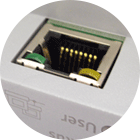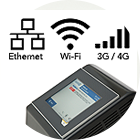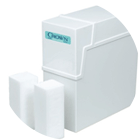Front Loading Autoclaves (120 - 344 Liters)
The Astell 120 – 344 liter front loading autoclave offers five chamber sizes, increased in capacity from the top loading range. The ‘Swiftlock’ front loading range of autoclaves allows the user a greater choice of options unavailable on the smaller ranges, as well as easy loading access.


Overview

A standard Swiftlock unit is fitted with heaters in the base of the chamber and is ideal for sterilizing liquids (media), discard, glassware and other instruments. Advanced options such as the Integral Steam Generator, External Jacket and choice of Vacuum can be applied to customise a vessel for many other applications such as liquids, fabrics and other porous loads.
Other options include Integral Steam Generators, Heated Jackets, Simple/Advanced Vacuum and a choice of Cooling options. Direct steam models are available at no extra cost. Astell can custom build the Swiftlock Front Loading Autoclave range to your specifications.
📄 Model: USB260 Heaters in chamber (120 liters)
📄 Model: USB270 Heaters in chamber (153 liters)
📄 Model: USB280 Heaters in chamber (247 liters)
📄 Model: USB290 Heaters in chamber (290 liters)
📄 Model: USB300 Heaters in chamber (344 liters)

Interested in Pricing?
Think the front loading autoclave might fit your needs? Let's get started.
Features
- 316 stainless steel electro polished chamber
- A choice of 120, 153, 247, 290 and 344 liter models
- A fully programmable Color Touch Screen controller
- FDA 21 CFR part 11 software option available
- Cooling Lock
- External pressure gauge
- Five password levels to stop lower level users making changes
- Holdwarm / Delayed Start feature
- Internal memory for storing up to 5,000 cycles
- Optimized for low water and power consumption
- Over Temperature Protection
- Safety valve test and emergency stop button
- Standard Astell safety features
- Timed/Pulsed Free Steaming
- Ultra-quick Swiftlock door mechanism
- USB interface for downloading controller data
- 316 stainless steel electro polished chamber
- A choice of 120, 153, 247, 290 and 344 liter models
- A fully programmable Color Touch Screen controller
- FDA 21 CFR part 11 software option available
- Cooling Lock
- External pressure gauge
- Five password levels to stop lower level users making changes
- Holdwarm / Delayed Start feature
- Internal memory for storing up to 5,000 cycles
- Optimized for low water and power consumption
- Over Temperature Protection
- Safety valve test and emergency stop button
- Standard Astell safety features
- Timed/Pulsed Free Steaming
- Ultra-quick Swiftlock door mechanism
- USB interface for downloading controller data
Options & Accessories:

Advanced Pulsar Vacuum
Suitable for all units with an integral steam generator (or external steam supply), the AVC001 Advanced Pulsar Vacuum option is ideal for sterilizing porous type loads and other loads where air pockets could easily form. An AVC001 vacuum cycle starts with a pre-vacuum which is followed by negative and positive pulsing. By introducing steam between vacuum pulses, air is forced out of the autoclave chamber under pressure; the best method for removing air from porous type loads and discard waste. Following the sterilization stage, a post vacuum removes the steam from the chamber. In combination with the jacket option, a drying stage then begins to ensure loads are touch dry upon removal.

Advanced Water Cooling
Water is circulated through cooling coils in direct contact with the outside of the autoclave chamber, resulting in a rapid decrease of the internal chamber temperature. Advanced Water Cooling offers substantial sterilization cycle time savings and is ideal for the busy Laboratory.

Air Ballast:
Air Ballast is especially useful for processing fluid cycles as it provides controlled reduction of the chamber pressure during the cooling phase. Effectively this prevents the ‘boiling over’ of bottled fluids that is frequently associated with rapid cooling systems.

Assisted Air Cooling
Addition of a powerful external fan to help reduce cool down times. The operation of the assisted air cooling system is controlled via the color touchscreen and is available on all models as an additional option, except for those fitted with a vacuum.

Autodrain
For use in ‘heaters in chamber’ autoclaves only. This feature can be selected on any cycle and will substantially decrease the time required to cool the chamber to a temperature where the door can be safely opened, especially when used in conjunction with Advanced Water Cooling or Assisted Air Cooling (see relevant options). At a pre-selected pressure during the cooling phase of the cycle, any remaining water in the chamber is evacuated to the drain. As the discharge water will be approx. 212F we would highly recommend that the ‘exhaust heat exchange system’ (AVC100) is ordered in conjunction with this option as well as ‘Autofill’ (AAP019) to avoid having to manually refill the chamber with water at the end of each cycle.

Autofill:
Maintains adequate water level within the chamber (for heaters in chamber models only). The water inlet is controlled by a level switch and complies with water bylaw regulations. The unit is readily connected to the water supply via a 1.5m flexible hose (supplied).

Heated Jacket
External Jacket Heating requires the steam generator (or direct steam supply) option (and normally in conjunction with the AVC001 vacuum option), external jacket heating effectively adds an additional layer to the outside of the autoclave chamber. This can then be independently heated by the steam supply to allow drying to take place at the end of a cycle, or can be flooded with water during cooling to aid cooling times.

Convection Fan Cooling
an internal fan is fitted in the chamber itself, creating turbulence. The fan needs to be ordered in conjunction with Water Cooling Jacket in order to be effective, but these combined options provide the most efficient way of cooling the chamber and load.

Exhaust Heat Exchange System:
For non-vacuum steam generator autoclaves and standard autoclaves with heaters in the chamber, due to the fact its primary purpose is to reduce the temperature of fluid leaving the chamber rather than steam. This option aims to significantly reduce the temperature of the exhaust/waste in situations where heat resistant drains are not present. Requires a mains water supply.

Integral Air Compressor
can be fitted to the machine to support the ‘Air Ballast’ option for fluid cycles or operation of SQUARE range automatic doors, where an on-site compressed air source is unavailable. A supply of compressed air is essential on all units with vacuum fitted.

Integral Steam Generator
Replaces heaters in chamber for improved control over steam production. Mains water supply required.

Blowdown Vessel:
For units fitted with Steam Generators only.

Load Sensed Process Timing
Allows the sterilization cycle to be controlled via the temperature in the center of the load (needed for liquids). A probe within the chamber is inserted into the load, and initiates the sterilization period once the probe reaches the programmed threshold temperature.

Spare Shelf
Additional shelf kit for large front loading autoclaves.

Castor Wheels:
Provide the flexibility to move the unit more freely.

Simple Vacuum
The cycle begins with a pre vacuum, reducing the chamber pressure and removing the majority of air. A freesteaming/air purge stage then begins. After the sterilizing stage is complete, water in the bottom of the chamber is expelled and then a post vacuum takes place, removing any remaining steam from the chamber and cooling the load.

Pulsar Free Steaming
An effective method of driving air from the chamber during the preparation phase of a sterilization cycle, and offers cycle time improvements over traditional methods of air purging.

Discard Container:
Allows the user to easily load batches of normally awkward shaped items, ideal for discard loads.

BSL-3 Compliance
Required when dealing with high-risk pathogens. A bacterial retentive filter is fitted to the exhaust ensuring nothing leaves the chamber without being sterilized (filter may vary from that pictured).

Ethernet Port
Allows the visual display of the color touchscreen controller on another device. This works by using a VNC Viewer (not supplied) and a PC or other hardware capable of running VNC. It also offers the ability to save cycle logs to a server or over FTP for backup.

Integral Data Printer:
Provides a permanent and traceable record of ‘Time, Temperature, Pressure, Batch No., Cycle Name’ etc. A cycle report print-out includes provision for operator signatures. The printer can also be used to provide reports of cycle settings and servicing information.

IQ/OQ Documentation
Provides the user with blank documents for them to complete. The IQ section includes details of calibration equipment, an order acknowledgement, PED (Pressure Equipment Directive) compliance, a Declaration of Conformity, FAT (Factory Acceptance Test), a drawing schedule, ISO 9001:2015 certification, pressure vessel specification and door safety checks. The OQ documentation includes an Automatic Control Test sheet (per cycle) and Chamber Temperature Distribution (per cycle).

Remote Maintenance, Diagnostics
Enables network connection by ethernet or Wi-Fi or 3G/4G (SIM card required). Allows an Astell Service Engineer remote access to the unit’s touchscreen controller, e.g. for settings and software updates or troubleshooting.

21 CFR 11:
Enables the autoclave to comply with Data Security, Data Integrity, Traceability/Audit Trails and Electronic Signature rules. Essentially this means any change made to a cycle, option, or device parameter will require an electronic user signature. All device changes and signatures are electronically logged and saved in a file format that cannot be altered in any way.

Water Softener
Recommended in hard water areas to reduce the build-up of limescale on heaters and pipework, and particularly recommended for units with steam generators. Unit includes a separate brine tank, allowing installation in difficult or restricted positions. Requires salt. (full details, including service requirements are available upon request).

SPF Seal (Double Ended Models Only)
This option is only relevant to pass-through or double-door autoclaves.
Options & Accessories:

Advanced Pulsar Vacuum
Suitable for all units with an integral steam generator (or external steam supply), the AVC001 Advanced Pulsar Vacuum option is ideal for sterilizing porous type loads and other loads where air pockets could easily form. An AVC001 vacuum cycle starts with a pre-vacuum which is followed by negative and positive pulsing. By introducing steam between vacuum pulses, air is forced out of the autoclave chamber under pressure; the best method for removing air from porous type loads and discard waste. Following the sterilization stage, a post vacuum removes the steam from the chamber. In combination with the jacket option, a drying stage then begins to ensure loads are touch dry upon removal.

Advanced Water Cooling
Water is circulated through cooling coils in direct contact with the outside of the autoclave chamber, resulting in a rapid decrease of the internal chamber temperature. Advanced Water Cooling offers substantial sterilization cycle time savings and is ideal for the busy Laboratory.

Air Ballast:
Air Ballast is especially useful for processing fluid cycles as it provides controlled reduction of the chamber pressure during the cooling phase. Effectively this prevents the ‘boiling over’ of bottled fluids that is frequently associated with rapid cooling systems.

Assisted Air Cooling
Addition of a powerful external fan to help reduce cool down times. The operation of the assisted air cooling system is controlled via the color touchscreen and is available on all models as an additional option, except for those fitted with a vacuum.

Autodrain
For use in ‘heaters in chamber’ autoclaves only. This feature can be selected on any cycle and will substantially decrease the time required to cool the chamber to a temperature where the door can be safely opened, especially when used in conjunction with Advanced Water Cooling or Assisted Air Cooling (see relevant options). At a pre-selected pressure during the cooling phase of the cycle, any remaining water in the chamber is evacuated to the drain. As the discharge water will be approx. 212F we would highly recommend that the ‘exhaust heat exchange system’ (AVC100) is ordered in conjunction with this option as well as ‘Autofill’ (AAP019) to avoid having to manually refill the chamber with water at the end of each cycle.

Autofill:
Maintains adequate water level within the chamber (for heaters in chamber models only). The water inlet is controlled by a level switch and complies with water bylaw regulations. The unit is readily connected to the water supply via a 1.5m flexible hose (supplied).

Heated Jacket
External Jacket Heating requires the steam generator (or direct steam supply) option (and normally in conjunction with the AVC001 vacuum option), external jacket heating effectively adds an additional layer to the outside of the autoclave chamber. This can then be independently heated by the steam supply to allow drying to take place at the end of a cycle, or can be flooded with water during cooling to aid cooling times.

Convection Fan Cooling
an internal fan is fitted in the chamber itself, creating turbulence. The fan needs to be ordered in conjunction with Water Cooling Jacket in order to be effective, but these combined options provide the most efficient way of cooling the chamber and load.

Exhaust Heat Exchange System:
For non-vacuum steam generator autoclaves and standard autoclaves with heaters in the chamber, due to the fact its primary purpose is to reduce the temperature of fluid leaving the chamber rather than steam. This option aims to significantly reduce the temperature of the exhaust/waste in situations where heat resistant drains are not present. Requires a mains water supply.

Integral Air Compressor
can be fitted to the machine to support the ‘Air Ballast’ option for fluid cycles or operation of SQUARE range automatic doors, where an on-site compressed air source is unavailable. A supply of compressed air is essential on all units with vacuum fitted.

Integral Steam Generator
Replaces heaters in chamber for improved control over steam production. Mains water supply required.

Blowdown Vessel:
For units fitted with Steam Generators only.

Load Sensed Process Timing
Allows the sterilization cycle to be controlled via the temperature in the center of the load (needed for liquids). A probe within the chamber is inserted into the load, and initiates the sterilization period once the probe reaches the programmed threshold temperature.

Spare Shelf
Additional shelf kit for large front loading autoclaves.

Castor Wheels:
Provide the flexibility to move the unit more freely.

Simple Vacuum
The cycle begins with a pre vacuum, reducing the chamber pressure and removing the majority of air. A freesteaming/air purge stage then begins. After the sterilizing stage is complete, water in the bottom of the chamber is expelled and then a post vacuum takes place, removing any remaining steam from the chamber and cooling the load.

Pulsar Free Steaming
An effective method of driving air from the chamber during the preparation phase of a sterilization cycle, and offers cycle time improvements over traditional methods of air purging.

Discard Container:
Allows the user to easily load batches of normally awkward shaped items, ideal for discard loads.

BSL-3 Compliance
Required when dealing with high-risk pathogens. A bacterial retentive filter is fitted to the exhaust ensuring nothing leaves the chamber without being sterilized (filter may vary from that pictured).

Ethernet Port
Allows the visual display of the color touchscreen controller on another device. This works by using a VNC Viewer (not supplied) and a PC or other hardware capable of running VNC. It also offers the ability to save cycle logs to a server or over FTP for backup.

Integral Data Printer:
Provides a permanent and traceable record of ‘Time, Temperature, Pressure, Batch No., Cycle Name’ etc. A cycle report print-out includes provision for operator signatures. The printer can also be used to provide reports of cycle settings and servicing information.

IQ/OQ Documentation
Provides the user with blank documents for them to complete. The IQ section includes details of calibration equipment, an order acknowledgement, PED (Pressure Equipment Directive) compliance, a Declaration of Conformity, FAT (Factory Acceptance Test), a drawing schedule, ISO 9001:2015 certification, pressure vessel specification and door safety checks. The OQ documentation includes an Automatic Control Test sheet (per cycle) and Chamber Temperature Distribution (per cycle).

Remote Maintenance, Diagnostics
Enables network connection by ethernet or Wi-Fi or 3G/4G (SIM card required). Allows an Astell Service Engineer remote access to the unit’s touchscreen controller, e.g. for settings and software updates or troubleshooting.

21 CFR 11:
Enables the autoclave to comply with Data Security, Data Integrity, Traceability/Audit Trails and Electronic Signature rules. Essentially this means any change made to a cycle, option, or device parameter will require an electronic user signature. All device changes and signatures are electronically logged and saved in a file format that cannot be altered in any way.

Water Softener
Recommended in hard water areas to reduce the build-up of limescale on heaters and pipework, and particularly recommended for units with steam generators. Unit includes a separate brine tank, allowing installation in difficult or restricted positions. Requires salt. (full details, including service requirements are available upon request).

SPF Seal (Double Ended Models Only)
This option is only relevant to pass-through or double-door autoclaves.